Did you know there are many edible weeds growing in your yard and garden? In fact, you probably already have several growing around your house.
These weeds provide a nutritious source of food, even though they’re weeds. You may not immediately think to harvest weeds for a nutritious meal, but it’s definitely possible.
I’ve compiled a list of 15 of the best edible weeds that you can easily find growing in your garden and lawn. Some of these weeds even taste great.
- Related article: Plants That Are Edible
1. Chicory (Chicorium intybus)
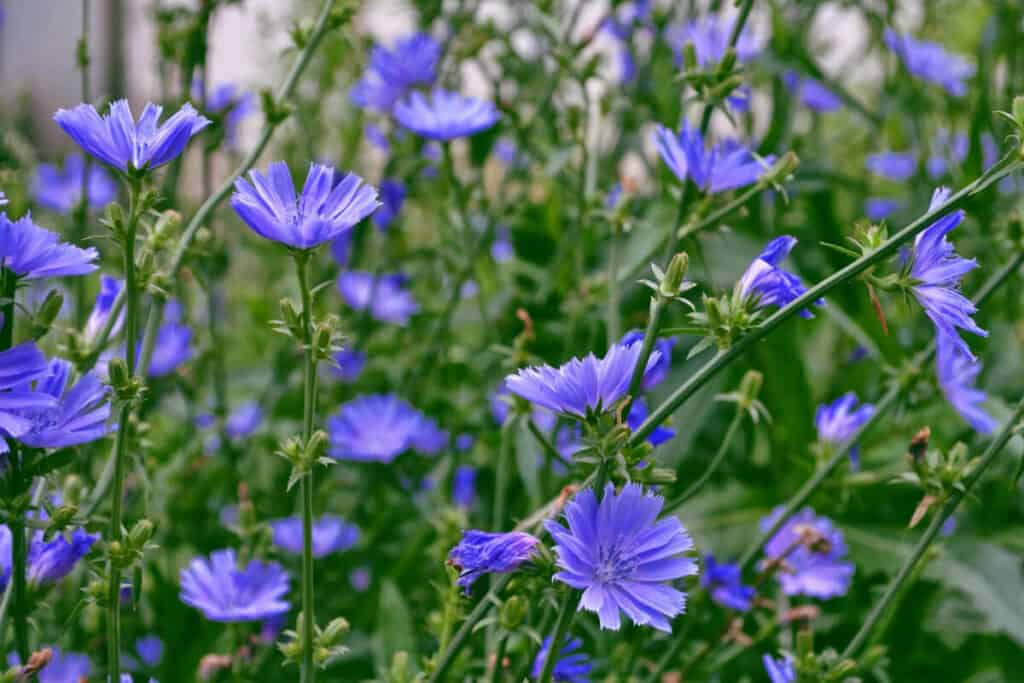
Chicory grows as a weed in most parts of North America, Europe, and Asia. This plant can grow up to 6 feet tall. It is one of the most well-known wild edible weeds, as it is very easy to identify thanks to its sky-blue flowers.
The leaf looks similar to that of other wild edible plants, such as the dandelion. It can be found in old fields, waste areas, weedy lots, and along roads.
All parts of the plant are edible. Even though the entire plant’s leaves and flowers can be eaten raw as a salad green, the leaves are also very bitter. Therefore, it’s better to mix them with other more palatable plants or to cook them to reduce bitterness. The roots can be roasted and ground down to use as a coffee substitute.
Chicory is very low in calories and high in fibers. It’s also rich in minerals, especially calcium, manganese, copper, iron and potassium. It is a good source of vitamins, in particular vitamin A, C, K, carotenoids, and folic acid.
2. Dandelion (Taraxacum officinale)
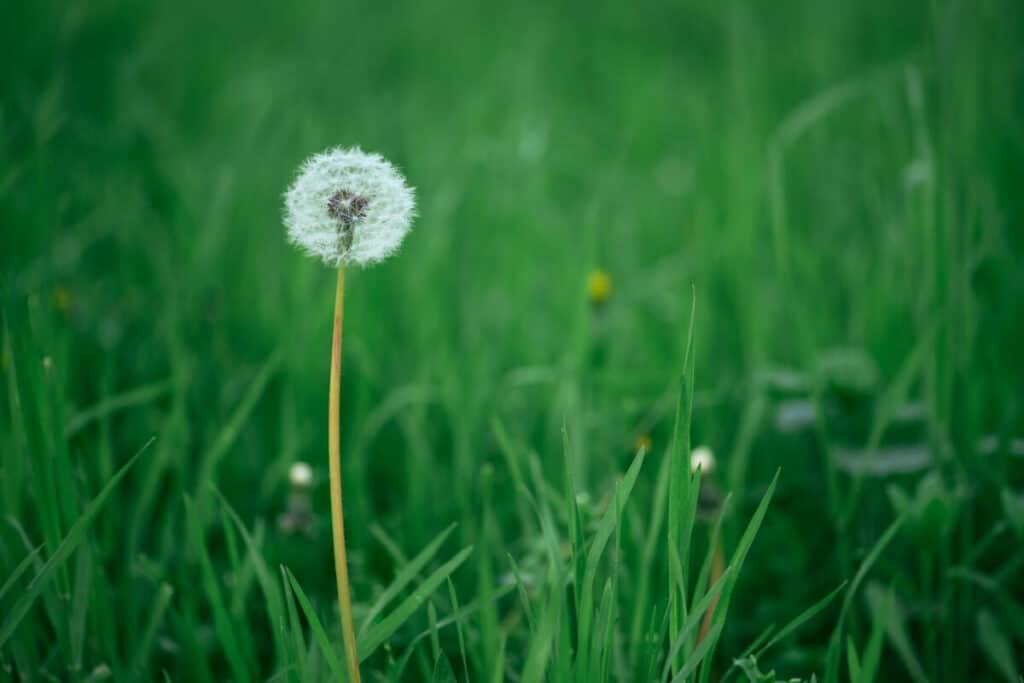
Dandelions are very common weeds throughout the Northern Hemisphere. These wild greens will grow in open, sunny areas.
The dandelion leaves and buds can be eaten as a salad or boiled for a few minutes. They taste slightly bitter and tangy. The roots are also edible, after having been boiled. They can also be used as a coffee substitute, like those of the chicory.
Dandelion flowers and leaves make up for a very nutritious plant. The greens are an excellent source of vitamins A, C, and K. They are also rich in iron, calcium, magnesium and potassium. The plant is full of antioxidants, mainly found in the flowers.
3. Ground Ivy (Glechoma hederacea)
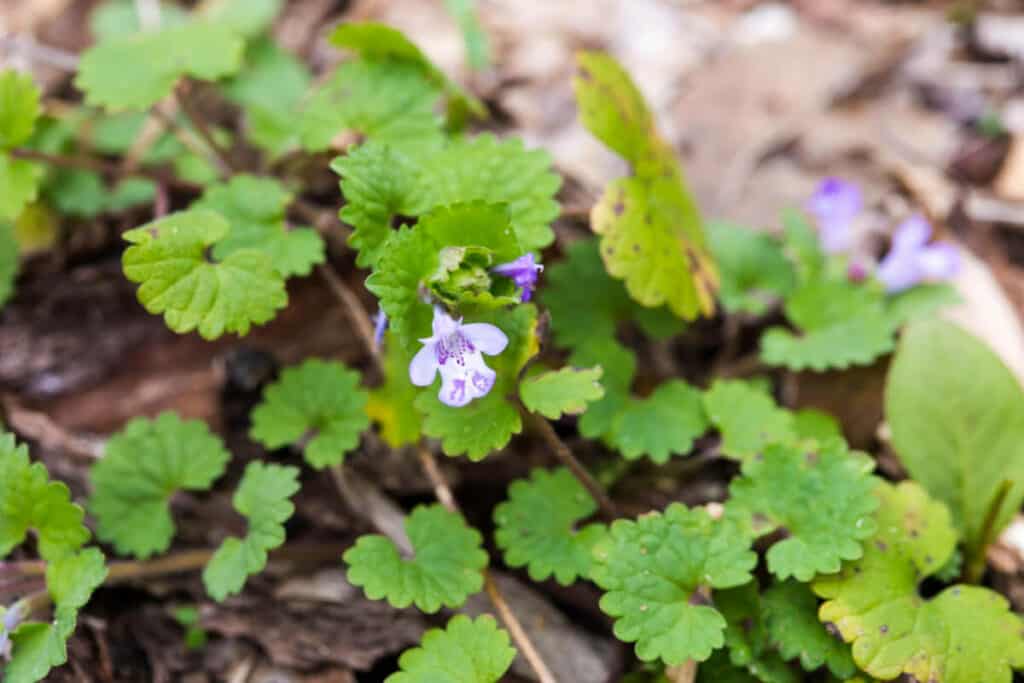
Ground ivy or gill-over-the-ground is an invasive plant native to Europe, now common all over the United States. It prefers shaded areas, but can also thrive in full sun. It can form wide mats as it propagates by stolons along the ground and can be easily found in lawns and gardens.
Ground ivy is closely related to mint, but it lacks the characteristic flavor. Instead, its taste is a bit of a mix between basil and sage, and very strong. For this reason, it’s best to use it sparingly and mix it with other greens when eaten raw. Ground ivy can also be cooked or dried and used as seasoning.
The best ground ivy leaves to harvest are the young ones, which are more tender and milder in flavor. Ground ivy is an excellent source of iron, potassium, and vitamin C.
4. Common Blue Violet (Viola sororia)
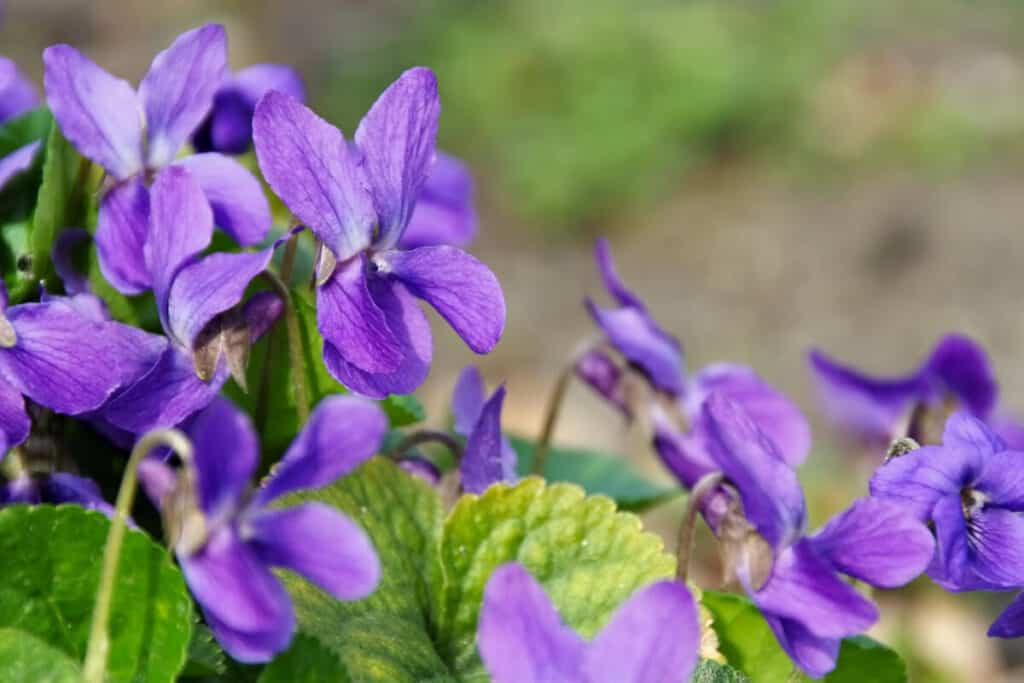
The common blue violet can be difficult to identify, as it has a lot of variability and is very similar to other species of the genus Viola. Exact identification is not a problem though, since the other violets are also edible.
This weed is very common in central and eastern North America and can be easily found in lawns, parks and abandoned lots.
The common blue violet leaves and flowers are both edible. On the other hand, the roots should be avoided because they can cause intestinal problems. Violets don’t taste particularly strong, but they have many uses. The leaves can be eaten raw or cooked just like any other green vegetable.
The flowers are perfect to add some color to your dishes, or to be made into candies. Violets are rich in vitamins A and C.
5. Hairy bittercress (Cardamine hirsuta)
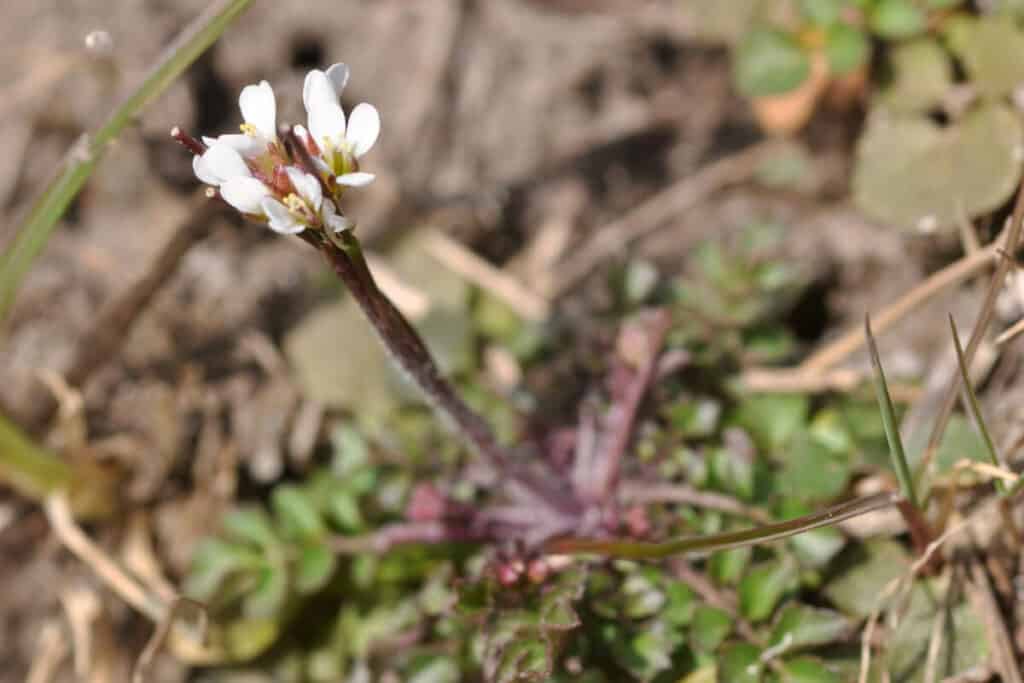
Hairy bittercress is a common weed in gardens and yards throughout the southern and eastern United States, as well as along the west coast. It also grows near streams, as it thrives on wet soil. It’s a winter green that prefers cool weather.
They can easily be spotted in autumn and winter, thanks to the contrast between the green leaves and the ground. Despite its name, the hairs that cover the leaves and stems are tiny and difficult to see.
Hairy bittercress weeds leaves are soft and tender and are perfect to eat raw in salads or sandwiches. They can also be used to make pesto or sauce. Another part that’s edible are the roots, which can be blended with vinegar to make a condiment.
Hairy bittercress is rich in vitamin C and beta-carotene. Its taste is a cross between cress and rocket, and it’s also described as a light mustard flavor. The taste is often compared to the mustard green.
6. Nettle (Urtica dioica)
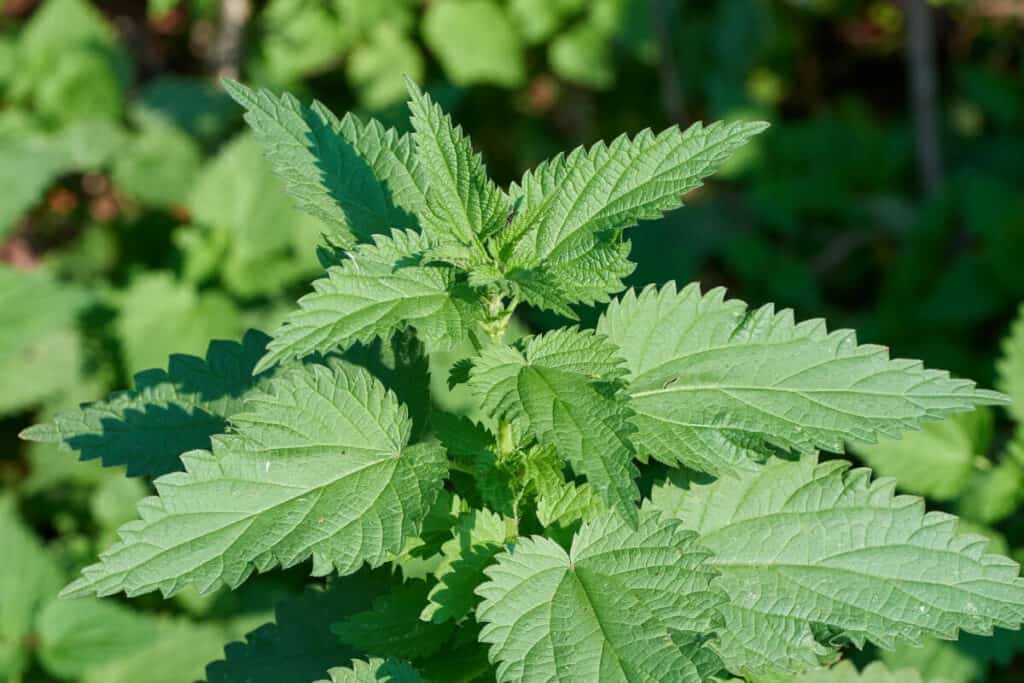
Stinging nettle, or simply nettle, is widespread both in Central and North America. It thrives in moist, disturbed areas.
Nettle must be picked with gloves because of its irritating bristles, but the taste is worth the hassle of harvesting it. It’s best to pick the young spring leaves, as they are the most tender.
Boiling nettle removes the irritating substances, so that the greens can then be enjoyed as they are or made into a purée. The boiling water can be used for soups or to make a beverage, adding sugar and lemon.
Stinging nettle is an excellent source of proteins, as it contains all of the essential amino acids. It’s also rich in vitamins A and C, minerals, and antioxidants.
7. Purslane (Portulaca oleracea)
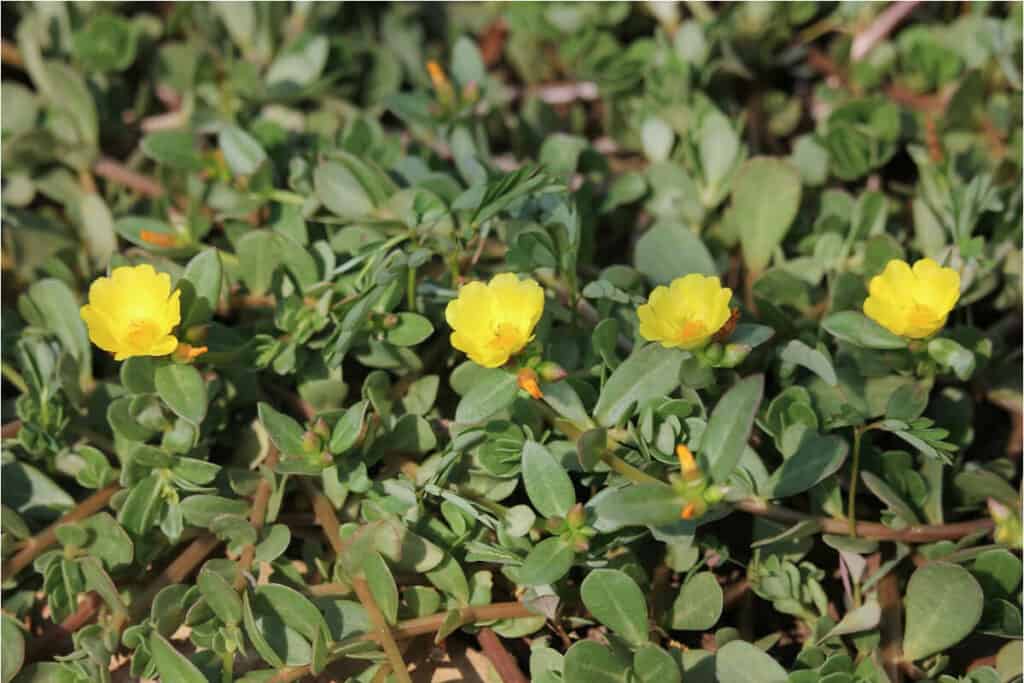
Purslane is a common garden weed and it’s easy to identify, thanks to its flashy stems and leaves, which are often reddish-purple in color. It grows lying flat on the ground and forms extensive mats that can cause problems when it infests farmed fields.
Purslane’s raw shoots taste fresh and tangy, and are perfect raw in a mixed salad. They can also be cooked with other herbs, for example, to make casseroles. It’s said to be one of the tastiest weeds, both raw and cooked. The stems can also be pickled, while seeds can be dried and ground to mix with flour.
Purslane is very nutritious and one of its best qualities is the high content of Omega 3 polyunsaturated fatty acids.
8. Sheep Sorrel (Rumex acetosella)
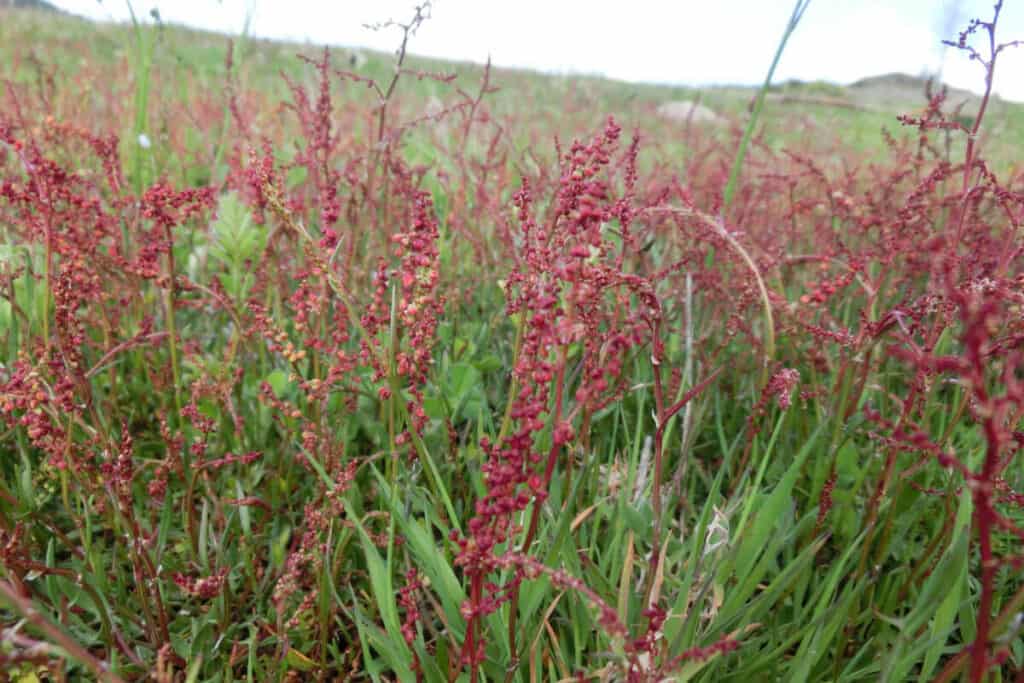
Sheep sorrel can easily be found in gardens and abandoned fields, both in North America and Europe. Look for its arrow-shaped leaves that have variegated edges. Other types of garden sorrel like French sorrel have larger leaves.
It’s related to many species of dock, such as curled dock (below), but sheep sorrel has the most distinctive sour taste. It prefers dry, acidic soil. The flowering plants can be tough to eat.
Sheep sorrel leaves are excellent to chew on during a hike, as they relieve thirst. They can be eaten as a salad, cooked with other greens, or boiled to make herbal tea. Avoid eating too many raw leaves, as the oxalic acid they contain can cause stomach problems.
Sheep sorrel is a good source of vitamin C, calcium, copper, iron, magnesium, manganese, and zinc.
9. Curled Dock (Rumex crispus)
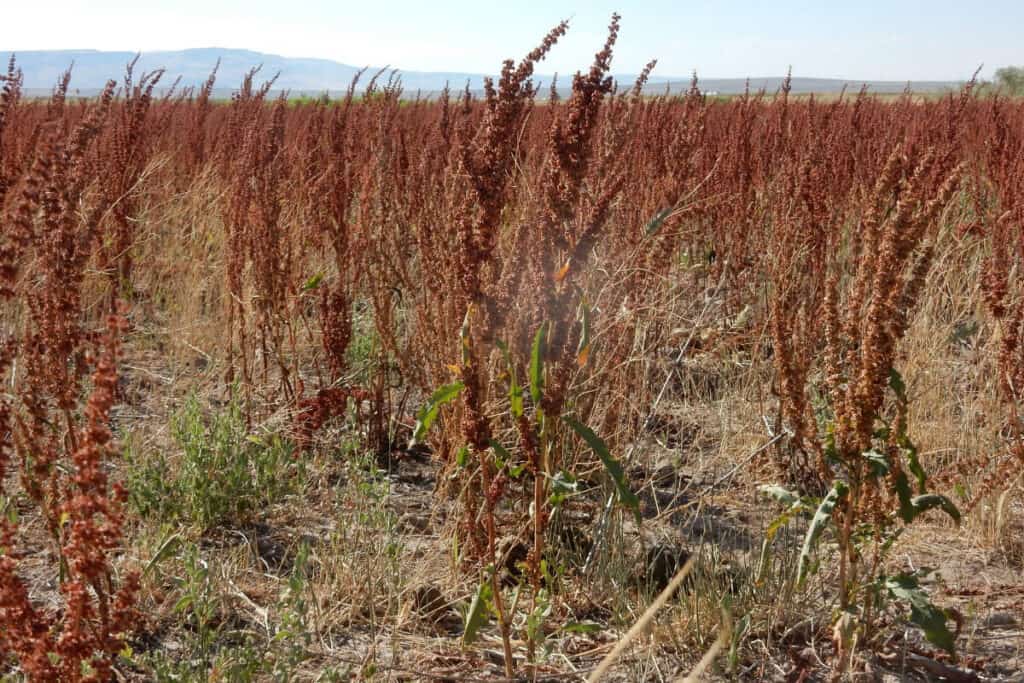
Also called sour dock or yellow dock, the curled dock herb is very large and is related to sheep sorrel, which shares the sour, tangy flavor. The leaves are wider and tougher than their relative, so it’s best to harvest the younger ones. You can also pick the leaves in late winter, when they get slightly yellow and red.
The curled dock’s young leaves can be eaten raw in a salad or boiled for about 10 minutes, while the older ones take longer to remove the bitterness. The young cooked leaves become tender and taste like beet greens.
Curly dock is very nutritious. It’s a good source of vitamin B1, vitamin B2, and iron. Also, it’s richer than carrots in vitamin A, and contains more vitamin C than oranges.
10. Crabgrass (Digitaria species)
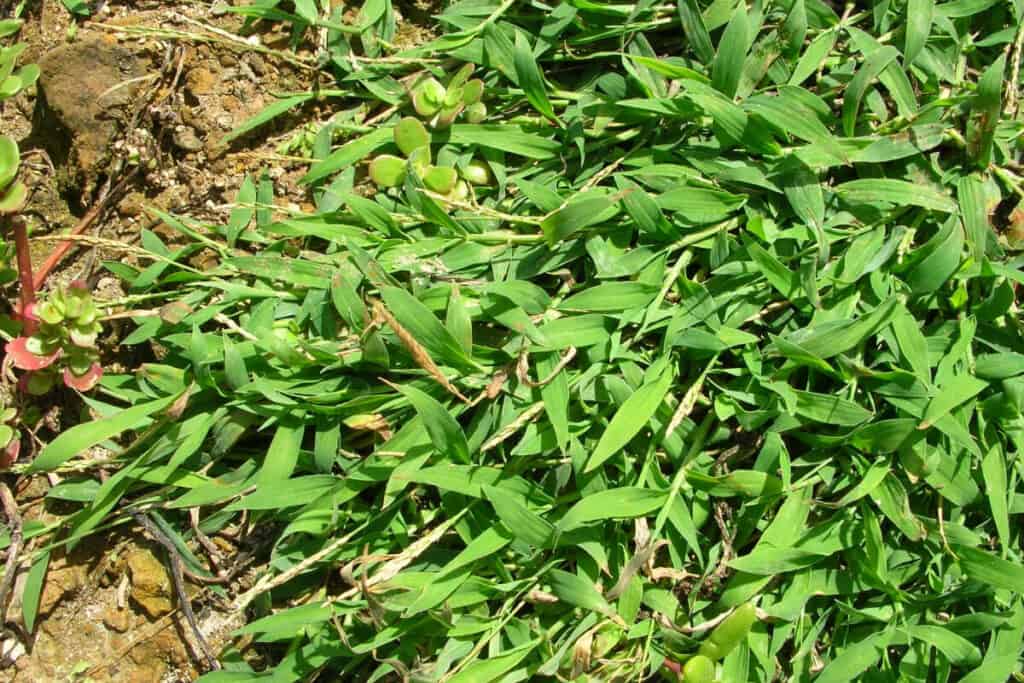
There are two main species of crabgrass which can be found in the US: large crabgrass (Digitaria sanguinalis) and southern crabgrass (Digitaria ciliaris).
They both flourish in disturbed open areas and are considered an invasive plant, as they are very fast-growing and can supplant cultivated crops.
Nowadays, crabgrass is mostly used as animal feed. In the past, though, it was cultivated for food, and it still is in some parts of the world. Its seeds can be harvested and ground into flour or used to make couscous.
This grass is very nutritious and in traditional medicine it was used for the treatment of cataracts and gonorrhea.
11. Plantain (Plantago species)
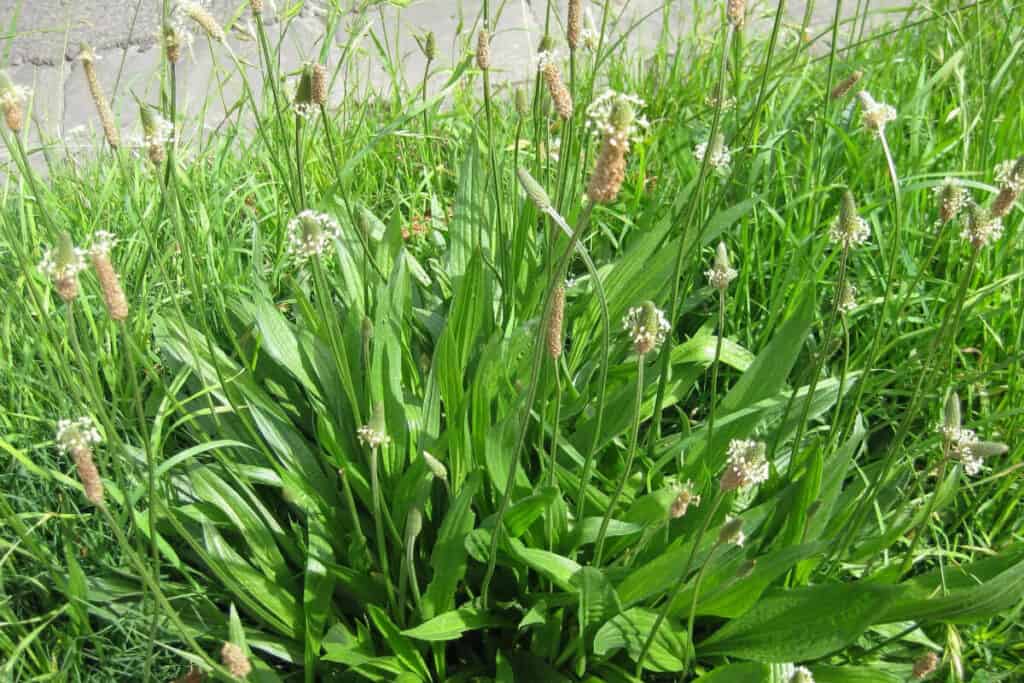
Plantain is one of the most common weeds in the world, especially in the temperate zones. It’s widespread in lawns and on roadsides. There are two main species, Plantago lanceolata, with long leaves, and Plantago major, with long ones. Both of them are edible.
Plantain leaves can be eaten raw or boiled. It’s best to use the young leaves, picked before the growth of the flowering stalk. The older leaves can also be consumed, but they are slightly bitter and tough to chew. The taste and consistency improve with cooking.
Leaves also make an excellent pesto when crushed and seasoned. The seeds can be dried and ground into a flour with a nutty taste. Plantain is a good source of vitamins and minerals and it’s also reputed to have medicinal uses.
12. Chickweed (Stellaria media)
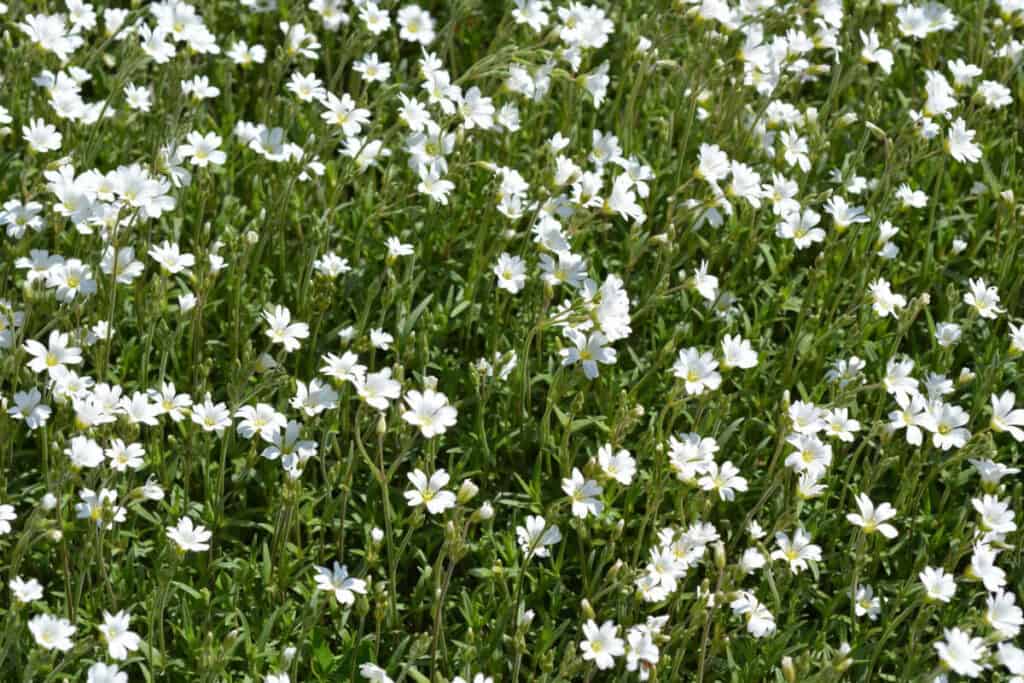
Chickweed is an annual plant native to Europe. It’s a common weed in yards, and can also be found in woodlands and among cultivated plants. It’s tiny and grows sprawled on the ground.
Chickweed should be picked young, when not blooming. To have a reasonable harvest, it’s best to pull up whole plants in clumps and then keep the most tender leaves and stems.
When young and fresh, chickweed is very tender and mild in flavor. It’s perfect to eat raw in salads, either by itself or mixed with other tastier greens. It can also be boiled, but just for a few minutes, because it would otherwise turn into mush.
13. Lamb’s Quarters (Chenopodium album)
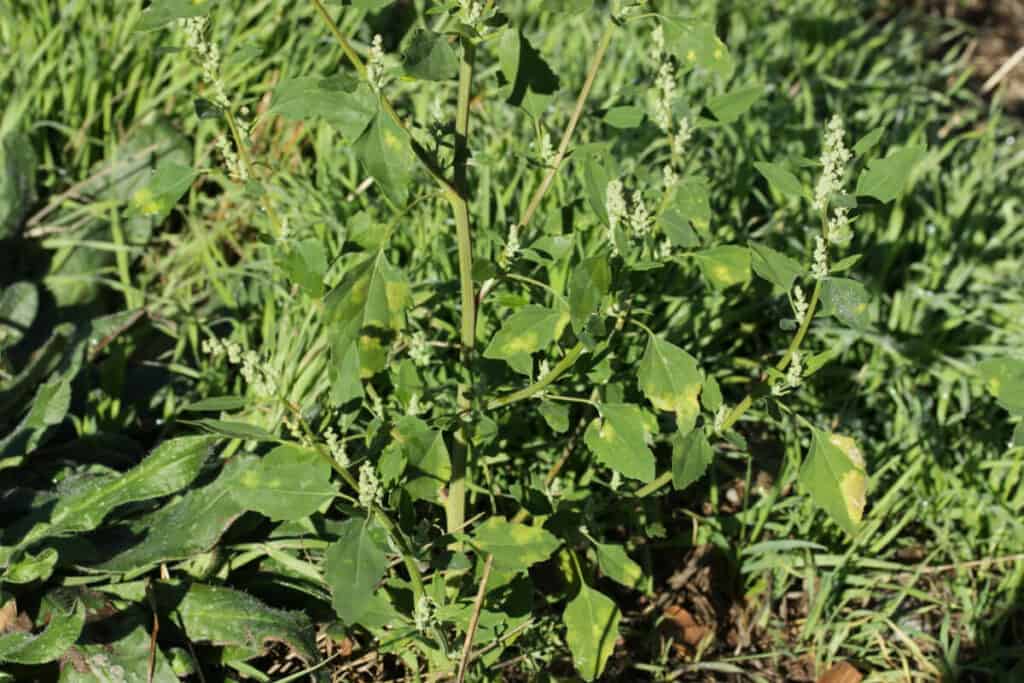
Lamb’s quarters is one of the most widespread weeds, commonly found in yards, disturbed sites, and on roadsides. It’s also one of the best tasting weeds you can find in your yard, with its mild, spinach-like flavor.
Lamb’s quarters can grow very tall, but it’s best to only harvest plants no higher than 10 inches. You can also pick the youngest stems from taller plants, which should be tender enough.
The lamb’s quarters leaves and stems can be eaten, either raw in a salad, or boiled for about 5 minutes. The seeds that are produced in autumn can be gathered to make black flour, which is a great addition to white flour in baking products. First, the seeds need to be boiled to soften them, so that they can then be crushed or ground.
This plant is very nutritious, as it’s rich in vitamins A and C. Attention must be paid when harvesting, as there are similar plants of the Chenopodium genus which can be toxic.
14. Pokeweed (Phytolacca americana)
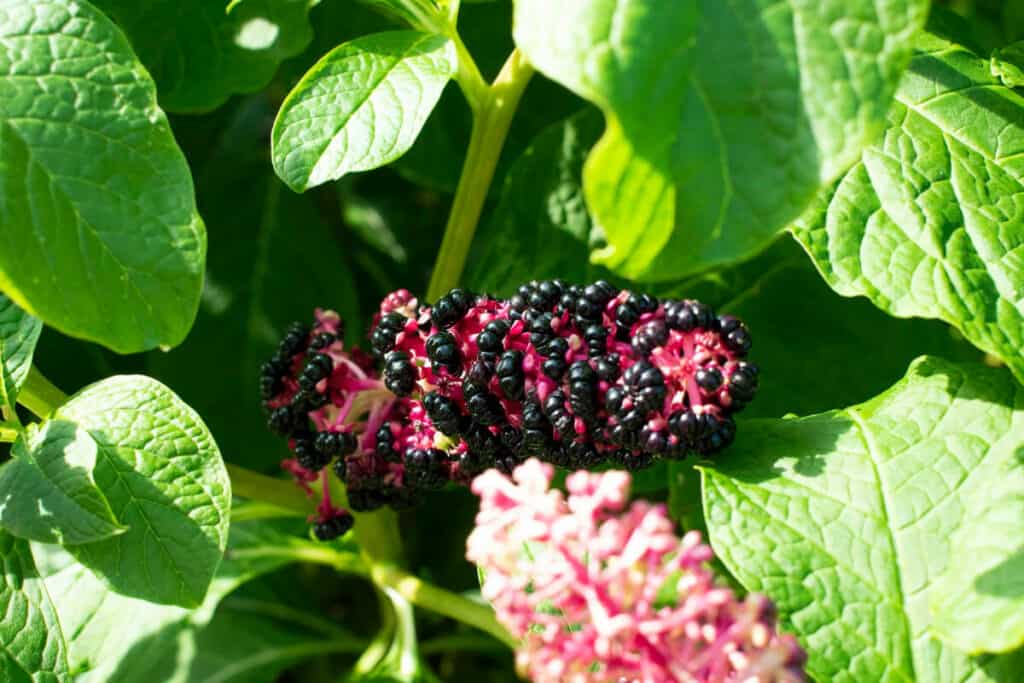
Pokeweed is common on the margins of woods and on roadsides, but it can also be found along fences. It’s a perennial herb identifiable by the unpleasant smell given out by the stems when broken.
The pokeweed plant’s young shoots grow next to the previous year’s stalks. These young shoots are the only edible part of the plant. The root is actually toxic, so it should be avoided at all costs. Also, avoid the older stalks and any shoots with a purple coloring.
Pokeweed cannot be eaten raw but needs to be boiled, taking care of changing the water a couple of times. Cooked shoots can also be peeled and pickled. This plant’s taste is similar to spinach.
Pokeweed is rich in vitamin A, vitamin B2, vitamin C, vitamin K, and manganese.
15. Black Mustard (Brassica nigra)
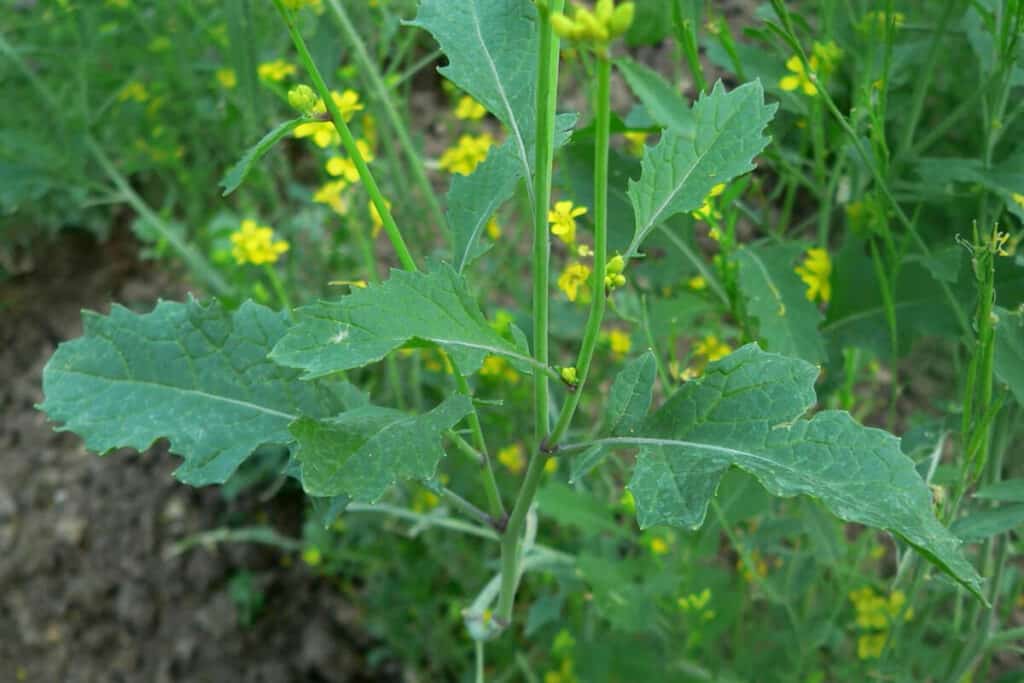
Black mustard is an annual herb native to Europe, now very common in yards and fields throughout Northern America.
Black mustard should be picked when young in the spring, otherwise the greens become bitter. They can still be harvested later on, removing the bitterness by blanching the leaves. This is done by tying the plants together with rooted ones and storing them in a dark place.
The young and blanched black mustard leaves can be eaten raw in salads, while any older greens have to be boiled for 30 minutes. They should be boiled for a few minutes, changing the water once.
The black mustard seeds are also edible, and taste hot and spicy. They can be used as a salad seasoning or to make mustard. Flowers and buds can be picked until almost all of them are open.
The black mustard weed is rich in vitamins A, B, and C.
Edible Weeds in Your Yard Final Thoughts
These 15 edible weeds growing in your garden and yard are easy to identify, and can provide you with some tasty treats.
If you want to learn more about how to identify other types of edible wild plants, check out these guides:

